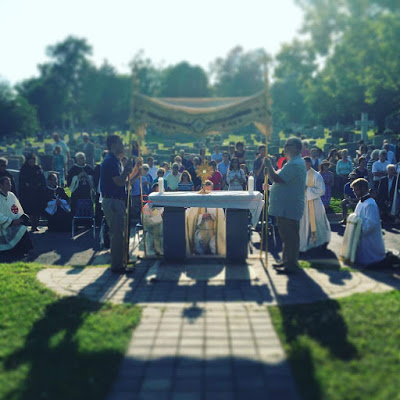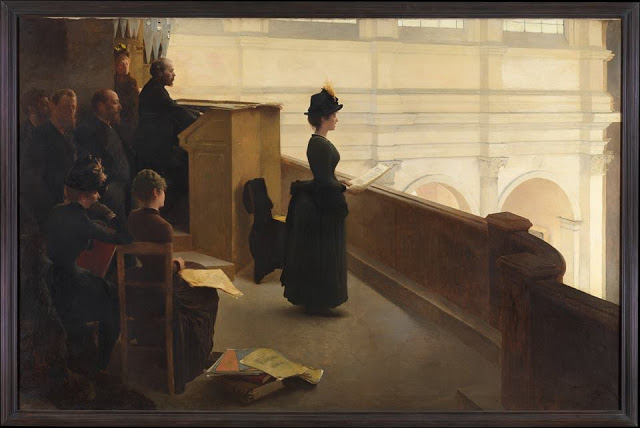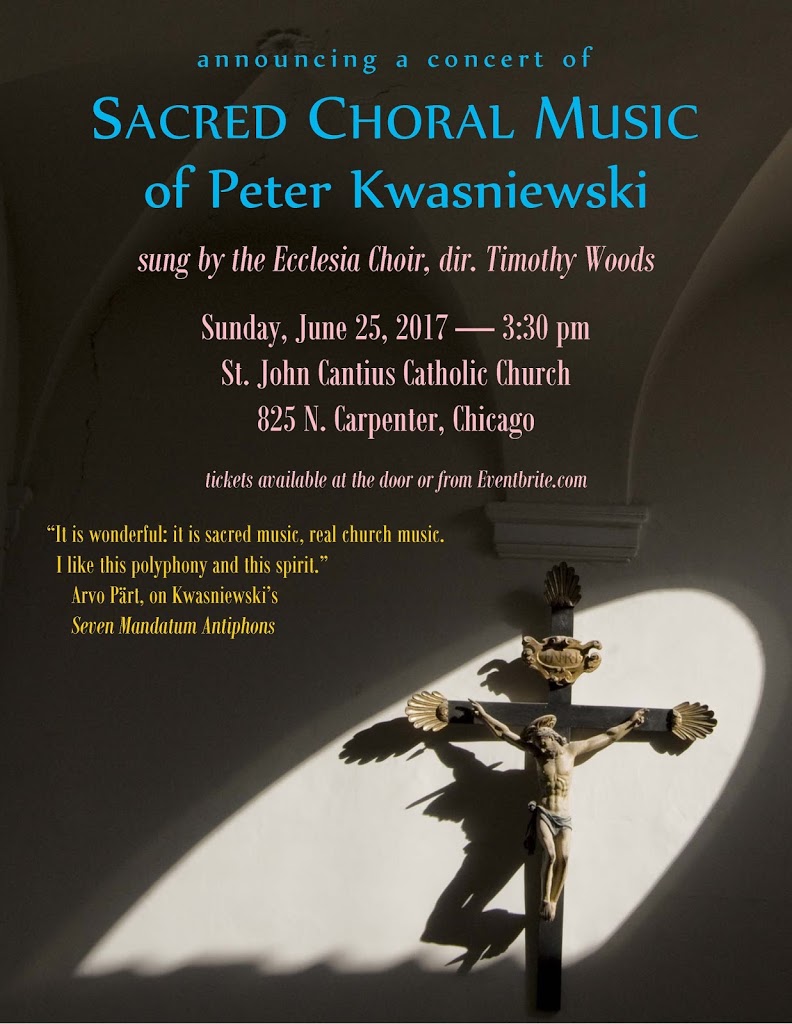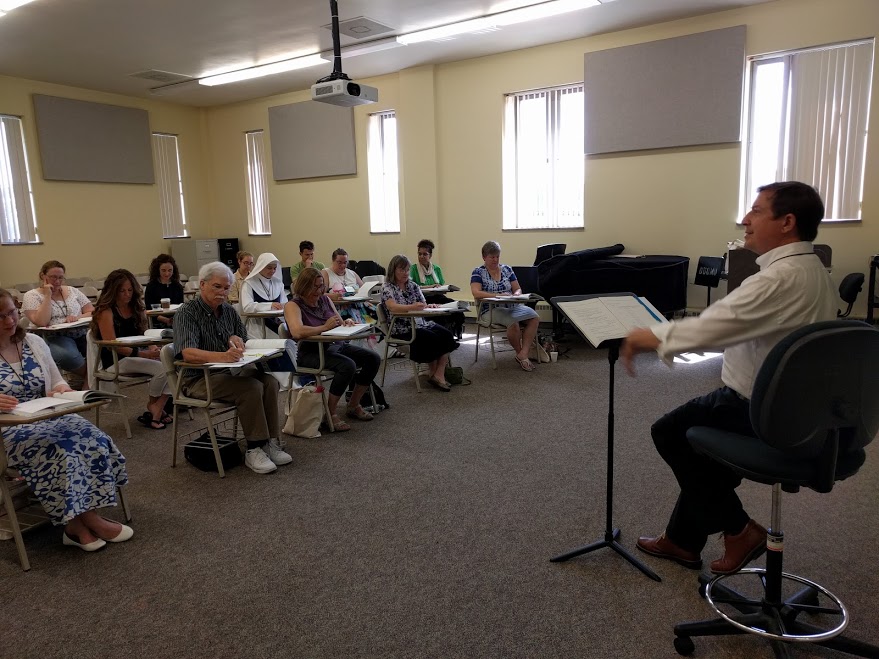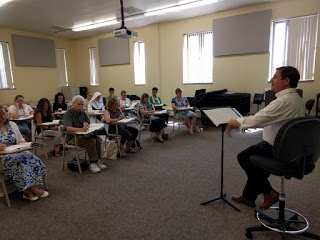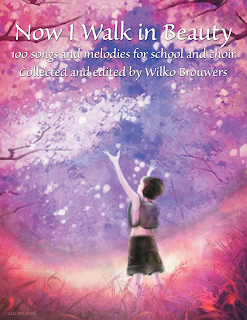Teaching little children to sing (K-1st grade)
In the past I’ve written a lot about starting children’s choirs, but for the last two years I’ve had some experience teaching groups of 5 and 6 year olds, and this is what I’ve learned so far.
- This is definitely the age to begin. Everyone I’ve worked with in these groups, after a little practice, can match pitch. In groups of 3rd graders and up, there will be students who have learned to sing off pitch without correction, and this is a very tough problem to correct. Like improper posture or breathing when learning an instrument, bad singing habits are also very difficult to correct. Get started in Kindergarten and everything will work out fine.
- Use imagery to suggest the kind of singing that is desired. My favorite is “a beautiful silver cloud right here above our heads.”
- The activity of singing will inevitably make some students want to vocalize in their own way, in a kind of self-expression. There are two ways to deal with this. One is to recall them to the task at hand, and there are times when this will be necessary. But more often what I do is give them 20 seconds or a minute to freely vocalize. I’ll say, “Now boys and girls, for the next 20 seconds, please quietly make the sound of your favorite animal [or bird].” This is usually all that is needed to get back on track.
- Gregorian Chant is tailor made for children of this age.
- The Do Re Mi scale is indispensable. I write it on the board at the beginning of every class and we review it and do recognition exercises. The students learn this method of internalization of the scale, and we sing songs on the solfege pitches (Mary Had a Little Lamb, Twinkle Twinkle, and this year, the Star Wars Title Theme). This video and those in its series are excellent.
- Sounds are your friend, books are not. In my older classes we use the Parish Book of Chant extensively, but at this age, books are a barrier to many children. “Finding the page” is not a skill most 5 and 6 year olds have, and it’s better to set books aside for the time being.
- The Kyrie is your best friend. Kyries are emotional and beautiful and have very few–but very attractive–syllables. In a year of once-a-week classes a Kindergarten class could profitably learn ten Kyries, along with much else. The intonation of Kyries also gives standout singers a chance to sing alone for a group, which is an educational experience in itself.
- Repetition is the teaching method I rely on most. I say, “Please listen first and then repeat.” I sing a line, they repeat. We keep working on each line or small portion of a line until they can sing it without error, and then move on. Slowly they gain mastery over larger chunks of the melody. Then I let them sing alone, so that they can “find their voice” as Jeffrey Tucker has always been fond of saying.
- No piano is necessary. I work entirely a cappella with young students, and this enables them to hear themselves and sing without “training wheels,”after the initial learning process.
At the Met: Lerolle’s The Organ Rehearsal
[Organist Randolph Nichols brings to our notice a once-famous work by painter Henry Lerolle (1848–1929).]
As some of my local colleagues know, besides being an organist and chant enthusiast I’m also a painter, a passion inherited from my mother. Sometimes those interests converge, as is the case in my admiration for Henry Lerolle’s The Organ Rehearsal, an oil on canvas painting dating from 1885 in the collection of the Metropolitan Museum of Art in New York City.
Having spent so much of my life in church lofts, it’s natural I would have a strong connection to this painting. With the exception of the fashion in women’s clothing, nothing much seems to have changed since 1885. Besides the artist’s deft drawing skills, solid use of perspective lines and division of the painting into dramatic value contrasts, I am drawn to the artist’s rendering of the dust covered floor (lofts are always the last place in a church to be swept), the blurring of the soloist’s feet and soft edges of her face (devices to integrate the figure into the scene so as to avoid a “pasted on” look), and the intentional omission of an organ music stand (a vertical shape at that juncture in the composition would be disruptive).
The rehearsal takes place in the choir loft of Lerolle’s parish church, Saint-François-Xavier in Paris, and features members of the artist’s family: his wife (seated to the left with gloved hand to cheek), his mother (standing behind the unidentified organist), his wife’s sisters, one seated in front (scandalously bareheaded and the wife of composer Ernest Chausson) and the soloist (the focal point of the painting). The painter himself, second from left, gazes vacantly to the side while the man standing to his left is thought to be Chausson. The young male figure behind the painter has not been positively identified.
While Lerolle was friend and patron to fellow artists such as Degas and Renoir (the latter painted several portraits of Lerolle’s daughters and of Lerolle himself), he was also a violinist and composer whose home was a meeting place for musicians that included d’Indy, Debussy and Dukas. (Debussy dedicated several piano works to Lerolle’s daughter Yvonne, including three of the Images.) It is not surprising then that a music rehearsal scene would be a subject of interest to the painter.
Within eleven years from its creation The Organ Rehearsal had become a picture held in high regard. Yet by 1928, it was relegated to the bowels of the Metropolitan and only re-discovered, cleaned, repaired and brought out of storage in 2007 and 2008.
If you would like more detailed information about the history and restoration of Lerolle’s most famous painting, I highly recommend this 30 minute lecture by Isabelle Duvernois of the Paintings Conservation department at the Metropolitan Museum of Art. Enjoy!
Concert Announcement: Sacred Music of Peter Kwasniewski
The following concert announcement comes to us from Friend of the Cafe Peter Kwasniewski.
I am very happy to announce an upcoming concert of my sacred choral works, including several premieres, to be sung by The Ecclesia Choir under the direction of Timothy Woods. The concert will held at St. John Cantius Catholic Church in Chicago on Sunday, June 25, at 3:30 pm.
Here is a preview of the concert program:
PART I: Music of the Holy Triduum
- Seven Mandatum Antiphons (2010), dedicated to Arvo Pärt
- After the Lord had risen from supper
- The Lord Jesus, after he had supped
- Lord, dost thou wash my feet?
- If I, your Lord and Master
- By this shall all men know
- A new commandment give I unto you
- Let there abide in you
-
Tantum Ergo II, III, V (2013), dedicated to Sean Gordon Lewis
-
Reproaches for Good Friday, Setting II (2013), in English & Greek
-
Reproaches for Good Friday, Setting V (2016), in Latin & Greek
-
Venit Jesus, from Three Easter Motets (2010)
PART II: Motets for the Church Year
-
Thee, O Mary, Will I Praise (2013), text by Angelus Silesius
-
O Clarissima Mater (2013), text by St. Hildegard of Bingen
-
Christus Natus (2014)
-
The Coventry Carol (2010)
-
My Jesus, Mercy (2013)
-
O Passio Magna (2014)
-
Non vos relinquam (1994)
-
Two Settings of Psalm 116 (2013), dedicated to Benedict XVI
Tickets may be pre-ordered at Eventbrite. Tickets will also be available at the door.
Please help spread the word among lovers of sacred music who live in the greater Chicago area. I will be there (of course…) and greatly look forward to meeting people before and afterwards!
More information
Register Now for a Ward Course!
You still have time… not much, but a little…
… to register to learn the Ward Method* with one of the finest Ward instructors in the US – Scott Turkington. Turkington will teach the CMAA’s Introductory Course this summer at Duquesne University as part of the CMAA’s summer course program.
In addition, the CMAA is also offering the next level of Ward Instruction for the first time this summer with instructor Wilko Brouwers, from the Netherlands. Brouwers’ course will include the use of his newly published book Now I Walk In Beauty: 100 Songs and Melodies for School and Choir. Thanks to the generous donors who have supported this new publication, the book will be literally “hot off the presses” for our summer programs.
We still have room in our classes for a few more participants. Please make plans to join us in Pittsburgh June 26-30 at Duquesne University.
There will be two courses offered:
Ward Method I – That All May Sing will be taught by Scott Turkington. Participants will learn the basic principles and the practice of this method developed by Justine Ward in the early 20th century and how it can be used with our 21st century children. Its fundamental principle is that all children can learn to sing, not just those with natural gifts.
Ward Method II – Intermediate moves beyond the first year. Wilko Brouwers will share his expertise and experience with the method to pass on more advanced techniques. It will expand on the training in Ward Method I.
The CMAA is convinced that this method has great value for developing future generations of singers, both those in the choirs and those in the pews. You can be part of that project.
You can learn more details about the courses and register by following this link:
*Please note that CMAA Ward Courses are not affiliated with the Ward Centre.
REGISTER NOW
Office Hymn to the Holy Spirit
Auctor perennis gloriae
O Source of glory without end,
Who with Your sev’n-fold graces send
Your Spirit to those who confess,
Defend us all in gentleness.
Remove all hindrances of mind;
Let sin’s strong powers vanquished be
And inner tears forever flee.
O keep our minds in quiet rest,
Perfect our work in righteousness.
Accept, O Lord, the prayers we give,
That we eternally may live.
The years, their seven days have run,
The age of time is nearly done,
For lo, the eighth and final nears,
When judgment day at last appears.
Redeemer, hear us, Lord, we pray.
Forget your anger on that day,
And let us not at your left stand,
But station us at your right hand.
So when in mercy you receive
The prayers of those, Lord, who believe,
Then may your glory ever new
Blest Trinity, return to you.
Trans. Kathleen Pluth
Celebrate May with a Dance
In some parts of the world, May seems like a long time coming. Here’s an amusing performance of Praetorious’ Philou. Enjoy it as a pleasant reminder of the secular that ran alongside the sacred, which we sometimes forget. And a celebration of multi-tracking, if that’s your pleasure.

